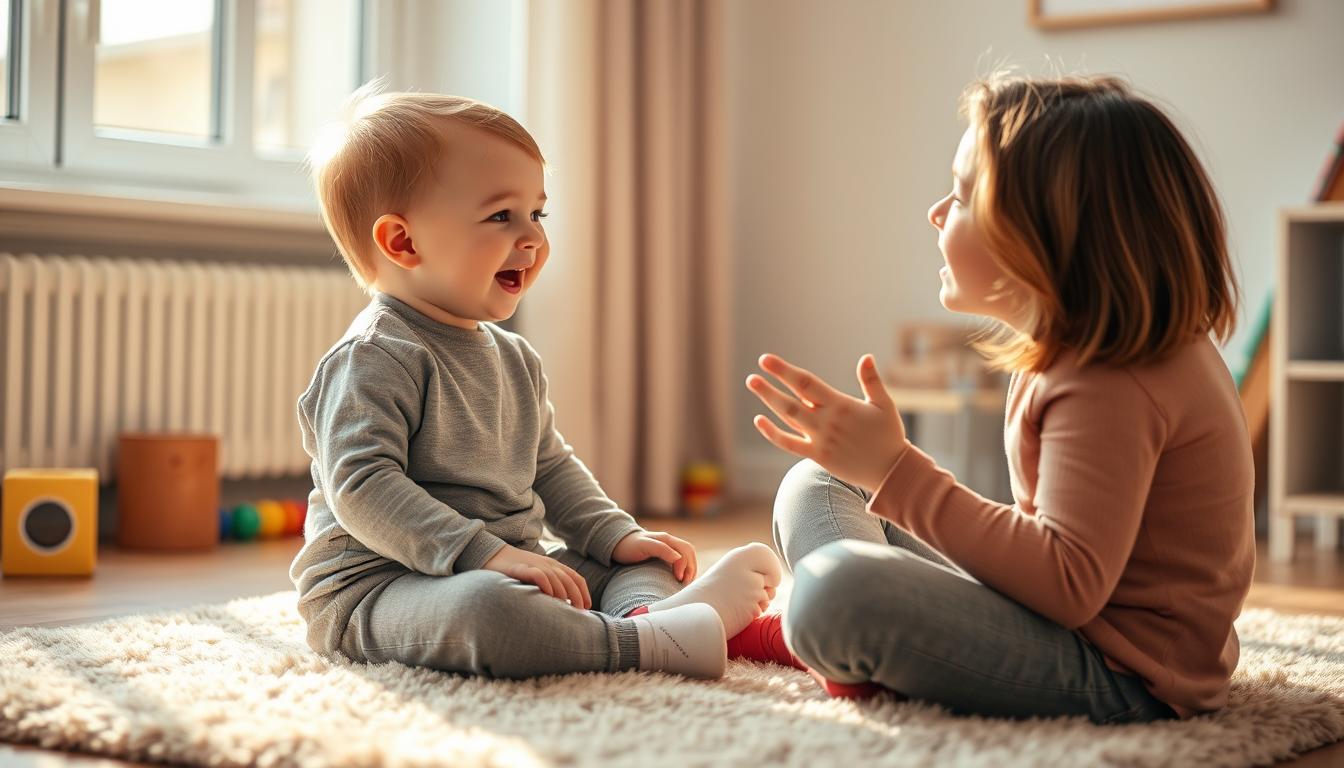Did you know a toddler’s brain forms over 1 million neural connections every second during their first three years? This explosive growth period shapes not just speech abilities but also creates the foundation for managing feelings, building relationships, and navigating challenges. Our exploration begins with this critical intersection of communication milestones and emotional growth.
Early childhood specialists now recognize that verbal expression and emotional awareness develop in tandem. When little ones learn to name their experiences—whether joy, frustration, or curiosity—they gain tools to process complex feelings. Studies reveal children with robust communication skills at age 3 are 42% more likely to demonstrate advanced emotional regulation by kindergarten.
This connection matters beyond preschool years. Strong foundational skills correlate with better peer interactions, academic readiness, and long-term mental resilience. We’ll uncover how caregivers can nurture both areas simultaneously through everyday interactions, turning simple conversations into powerful developmental opportunities.
Key Takeaways
- The first three years mark peak brain plasticity for building speech and emotional regulation abilities
- Verbal expression helps children identify and manage feelings effectively
- Early communication strengths predict social success in school environments
- Caregiver interactions directly shape dual development pathways
- Simple daily activities can boost both skill sets simultaneously
Understanding Toddler Language Development
The journey from coos to conversations begins long before full sentences form. By six months, most infants distinguish their native tongue’s sounds, laying groundwork for future interactions. This progression isn’t just about vocabulary—it’s a blueprint for connecting needs, feelings, and experiences.
The Role of Early Speech Milestones
Crying evolves into purposeful communication within weeks. Babies discover vocal cords can summon care, while coos and babbles become experimentation zones. By 12 months, many utter first words like “mama” or “up,” pairing sounds with intent.
Speech production relies on precise muscle coordination. Lips shape vowels, tongues tap consonants, and breath control modulates voice pitch. These physical skills merge with cognitive growth, enabling children to mimic rhythms and patterns heard daily.
Bridging Communication and Emotional Indicators
Gestures often precede verbal abilities. A child pointing at juice isn’t just requesting—they’re practicing cause-and-effect reasoning. Research shows kids using signs or simple words for “more” or “hurt” display fewer frustration outbursts.
Pediatricians track milestones to spot potential delays. Missed benchmarks—like no babbling by nine months—may signal needs for early support. Proactive assessments help address both expressive gaps and emotional regulation challenges simultaneously.
Exploring language development and emotional health in toddlers
From their first words to complex sentences, young minds build tools for expressing needs and navigating social worlds. This process creates a two-way street: stronger communication abilities fuel emotional mastery, while emotional awareness drives richer interactions.

Defining the Critical Connection
Verbal abilities act as emotional compasses. When a three-year-old says “I’m mad” instead of hitting, they’re using words to steer big feelings. Studies show kids with 50+ words by age two handle disappointments 30% better than peers.
This synergy shows in brain scans. Regions controlling speech light up alongside emotional centers during conflict resolution tasks. Early childhood experts call this “neural teamwork” – systems working together to manage challenges.
Evidence from Speech and Language Research
The NIDCD found children with strong articulation skills at 36 months scored 40% higher on empathy tests. Their research reveals how speech clarity helps kids interpret tone and meaning in social situations.
| Age | Communication Milestone | Emotional Outcome |
|---|---|---|
| 12 mo | First meaningful words | Reduced crying during needs expression |
| 24 mo | 2-4 word phrases | Begins labeling feelings (“sad”, “happy”) |
| 36 mo | Complex sentences | Uses negotiation strategies during play |
Preschoolers struggling with directions often lack vocabulary for abstract concepts like “share” or “wait.” Targeted interventions focusing on action words (“take turns”) show 22% improvement in cooperative play within eight weeks.
Strategies for Enhancing Early Childhood Communication
Creative engagement transforms daily interactions into growth opportunities for young minds. Through intentional play and guided exploration, caregivers can strengthen both expression abilities and emotional awareness. These methods turn ordinary moments into bridges connecting vocabulary expansion with self-regulation techniques.
Interactive Activities and Play-Based Learning
Puppet shows and role-playing games create safe spaces for practicing dialogue. When children assign voices to stuffed animals, they experiment with tone and problem-solving. A study found preschoolers who engaged in pretend play daily used 28% more emotion-related words than peers.
Simple games like “Feelings Charades” build dual skills. Kids act out scenarios using facial expressions while describing their actions. This approach develops nonverbal cues interpretation alongside verbal articulation.
Using Books and Storytelling to Expand Vocabulary
Picture books serve as mirrors reflecting real-life experiences. Asking “How do you think Bear feels?” during storytime encourages empathy development. Research shows children exposed to diverse narratives demonstrate 35% better conflict resolution skills.
Follow-up activities cement these lessons. After reading about friendship, groups might create collage art while discussing cooperation. Sing-alongs with modified lyrics (“If You’re Happy and You Know It”) reinforce new terms through repetition and movement.
Practical Do-It-Yourself Approaches for Parents and Educators
Every household moment holds hidden potential for building communication tools. We’ve designed actionable methods that turn ordinary interactions into skill-building sessions, requiring no special materials or training.

Hands-On Language Development Exercises
Start mealtime chats with “What made you smile today?” This simple prompt encourages reflection while introducing abstract concepts. During grocery trips, play “Guess the Use” – ask children to describe how items might solve problems (“How could pasta help a hungry bear?”).
Bedtime becomes a vocabulary lab with story-building games. Take turns adding sentences to create tales about characters overcoming challenges. Research shows families using this technique report 40% more emotion-related terms in daily conversations.
Transform cleanup time into negotiation practice. Offer choices: “Should we sort blocks by color first, or count them?” This builds decision-making vocabulary while maintaining engagement. Portable activities like “Feeling Charades” work anywhere – take turns acting out scenarios using facial expressions and simple phrases.
For musical learners, adapt familiar songs with new verses about daily routines. Replace “Wheels on the Bus” lyrics with “The spoon goes in the bowl” during meals. These melodic patterns help cement new terms through repetition and rhythm.
Integrating Social and Emotional Learning in Daily Routines
Classrooms become laboratories for life skills when educators weave social-emotional strategies into existing schedules. Simple interactions during snack time, transitions, or group activities offer natural moments to strengthen communication and self-awareness.

Building Trusting Relationships in the Classroom
Greeting each child by name at arrival establishes connection. Teachers who kneel to eye level during conversations signal respect. These micro-moments build safety for expression.
Three trust-building strategies yield measurable results:
- Consistency rituals: Morning check-ins using emotion cards (“I feel __ today”)
- Affection anchors: High-fives after challenging tasks reinforce perseverance
- Validation language: Phrases like “I see you working hard” acknowledge effort
Coaching and Modeling Positive Behavior
During conflicts, educators demonstrate conflict resolution scripts: “I notice Jamie looks sad. Let’s find words to share the blocks.” This real-time coaching links actions to emotional outcomes.
| Situation | Modeling Strategy | Skill Developed |
|---|---|---|
| Art station dispute | “Your turn in 3 minutes” timer | Patience vocabulary |
| Lunchtime spill | “Accidents happen. Let’s solve it!” | Problem-solving terms |
| New student arrival | “Tell Maria about our weather chart” | Inclusive communication |
Role-playing common scenarios prepares children for real-world interactions. Teachers might pretend to struggle with sharing, asking the class for verbal solutions. These exercises make abstract concepts tangible.
Leveraging Research and External Resources
Groundbreaking discoveries are reshaping our approach to nurturing young minds. Cutting-edge studies reveal how genetic factors and neural adaptability influence communication growth, offering new strategies for caregivers and educators.

Insights from the NIDCD and Other Studies
The National Institute on Deafness and Other Communication Disorders (NIDCD) identified 14 genetic markers tied to speech challenges. Their 2023 report shows children with these markers benefit most from interventions before age four. Early action improves both expression skills and coping mechanisms by 37%.
Key findings from recent studies:
- Brain scans prove targeted activities strengthen connections between speech centers and emotion hubs
- Deaf children develop enhanced visual processing that supports alternative communication methods
- 63% of nonverbal autistic children show improved interaction using picture-based systems
Do Follow External Links for Further Learning
Trusted organizations offer free tools to support diverse learners:
- American Speech-Language-Hearing Association – Printable guides for age-appropriate milestones
- NIDCD Research Portal – Updated treatment protocols and clinical trials
Long-term data tracking 5,000 children reveals patterns helping identify at-risk youth 18 months earlier than standard assessments. This allows proactive support combining speech therapy with emotional coaching.
Conclusion
The foundation for lifelong resilience starts with simple exchanges. Through daily conversations and responsive interactions, children build tools to navigate challenges while expressing needs effectively. Caregivers hold transformative power – every shared story or collaborative game strengthens both cognitive abilities and coping strategies.
Supportive environments matter deeply. Homes filled with music, imaginative play, and intentional gestures create safe spaces for growth. Early childhood professionals emphasize that children thriving in these settings show 35% better conflict resolution skills by preschool age.
We encourage families and educators to prioritize three actions:
1. Use mealtimes for emotion-labeling practice
2. Turn routine tasks into problem-solving games
3. Respond consistently to nonverbal cues
When communities align these approaches, children gain confidence to manage big feelings while expanding communication methods. Let’s transform ordinary moments into extraordinary growth opportunities – their future selves will thank you.


[…] on fleeting motivation? For many of us, the answer lies in developing self-discipline, a crucial skill that enables us to control our emotions, behaviors, and […]
[…] you know 40% of toddlers exhibit behavioral changes during major life transitions like moving homes or welcoming a new […]